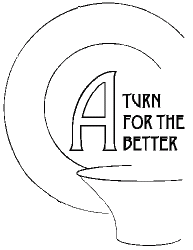|
This article originally appeared in the Fall '98 edition of American
Woodturner vol. 13, issue 3. The following text may vary
slightly, as I'm using my original version, not the edited version found
in the magazine (although they are very close) because I don't have
an electronic version of it. I've also used some different
and additional photos.
I hope you enjoy it - I (Kevin Miller) retain all copyrights to it however
it may be reproduced for non-commercial purposes as long as full credit
is given both to myself as author (and copyright holder) and to its original
publication. As a curtosy, I'd appreciate knowing when and
where it is used. Just drop an email to atftb at alaska dot net.
|
|
In the December 1997 issue of American Woodturner, Christian Burchard
presents a very nice multi-piece candlestick project noting that he "...had
great difficulty coming up with a good design. I kept seeing Rude
Osolnik's candlesticks; to my mind, they are the just the simplest and
most elegant candlesticks turned from a single piece of wood."
Well, that was all the motivation I needed to start playing with candlestick
design. I'm not claiming that my design is going to put Rude out
of business, but I did come up with a candlestick that I'm pleased with.
It may be turned from a single piece of wood, or built up from smaller
pieces and is an excellent project for beginners to hone their skew skills
on.
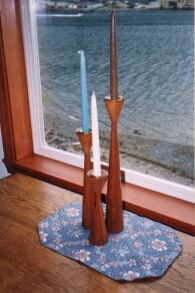
|
My Great Uncle Reuben Bowman taught woodshop
in the highschool in Stafford Kansas until retiring in the '60s, and made
candlesticks similar to Osolnik's many years ago for all the significant
ladies in his life, my mother being one of them. I used his design
as a starting point rather than Osolnik's although the similarity is obvious,
as is the distinction (see photo at left). Personally, I prefer Reuben's
design, but I'm admittedly biased.
I didn't want to reinvent the wheel, but rather take an existing design
and add my own element to it which is one of the reasons that I chose my
uncle's design over Osolnik's; I came by it honestly. Reuben's candlesticks
have a long straight taper and a narrow waist. Similar to Osolnik's,
they are weighted in the base. I decided that I didn't really want
to weight the base and hide it with felt or a wood plug, so I settled on
a somewhat shorter piece with a wider waist. I also thought that
a slight convex curve to the taper would enhance the piece. Finally,
I cut a small chamfer at the point the base meets the top, accenting the
waist. |
It was one thing to make a candlestick that I liked.
The next step was to make matching candlesticks. For this I use a
small gauge that I cut out on the band saw (see figure 1). I begin
by mounting a billet between centers and rounding it to my working diameter
using the gauge to size the billet. Because I'm right handed, I orient
the blank so that the top of the candlestick is at the headstock end.
This permits me to cut the long taper of the bottom from right to left.
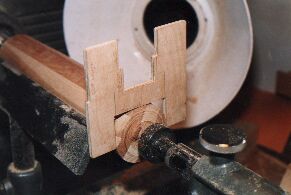
|
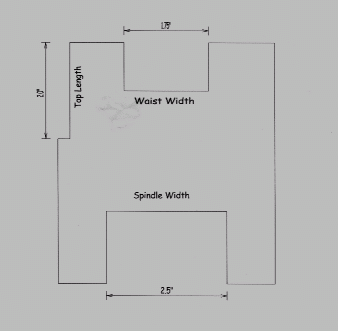
Figure 1 |
The first inch or so of the blank will be wasted, so any small checks in
it may be ignored. Brass candlestick inserts require a 7/8" hole,
but my drive center is 1". Since its important to cut cleanly all
the way to the edge of the (future) candle hole, I turn the first inch
or so of wood down to a bit proud of a 1" diameter tenon. Later,
I'll taper it to less than 7/8" and clean up the top.
Next I establish the length of the candlestick, and take the bottom
down in a similar fashion.
I don't take the diameter down too small at this stage; its important
to maintain some bulk until I've completed the body of the candlestick.
I usually leave the bottom tenon about an inch thick at this stage.
I use a peeling cut to take the wood on the ends down quickly, however
I generally cut each end about 1/16" longer than the finish length of the
candlestick because the peeling cut causes significant tear-out of the
end-grain fibers. I clean up the ends (the top and bottom of the
candlestick) with a shearing cut with the skew, but more on that later.
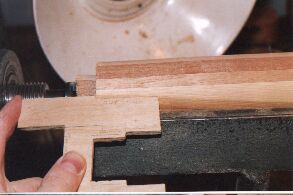 |
Next, I use my gauge to mark the length of the
head by holding the notch against the top, and scoring the billet with
my skew. Using a parting tool, I cut the billet on the left side
of the line down to the diameter of the waist. The right hand corner
of this cut defines the top of the chamfer which we'll cut in a moment.
Now, its a simple matter to pare down the wood until a nice taper is
established. I do the same on the left side of the cut, tapering
the head until it touches the left hand corner of the groove, ending the
tapers about a quarter inch apart with a small "flat" between them. |
Beginning at what was the right hand corner of the cut, I turn a small
chamfer towards the top. Returning to the head of the candlestick,
I taper it until it almost meets the bottom of the chamfer.
By not quite cutting to the bottom a slight shadow line highlights the
waist.
At this point I sand the piece, then turn away the excess at the top
and the bottom with a shearing cut using the skew.
It is important to make sure that your skew is very sharp for this
cut, especially on soft or spalted wood where it is hard to get a clean
surface.
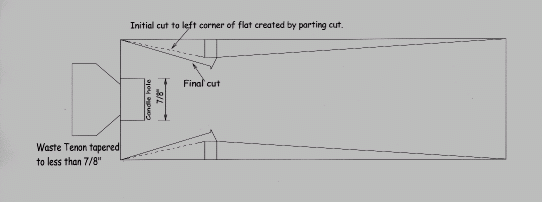 |
It is important to make sure that your skew is very sharp for this
cut, especially on soft or spalted wood where it is hard to get a clean
surface.
I prefer to undercut the bottom slightly, insuring the candlestick will
sit flat. |
Returning to the top tenon, I pare down the right side of the tenon
until it is less than 7/8" thick). Taking a sheering cut, I true
up the top, cutting past the edge of the future hole. When I'm satisfied
with the top, I do the same on the bottom, however I turn the tenon down
to about 1/8", then remove the candlestick from the lathe and cut the remainder
of the bottom off with a bench chisel.
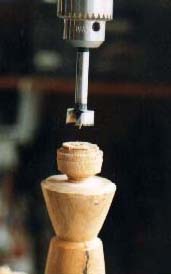 |
Now all that's left to do is to drill out the top.
Recall that we still have a tenon on the top that is over an inch wide,
tapering down to less than 7/8" where it meets the candlestick. The
easiest way to rid of that is by positioning the piece in my drill press
and just drilling it out, since I have to drill it anyway for the candle
holes and brass inserts. I use a 7/8" Forstner bit, using the mark
left by the drive center as my guide.
Left: drilling out the candlestick tenon. Note that the width
of the Forstner bit exceeds the taper of the tenon.
|

A trio of yellow cedar candlesticks ready to be drilled.
|
| At some point, I will pass the 7/8" diameter
of the tenon, which will then spin freely on the drill bit. I stop
the drill and remove it. Because Forstner bits have a small point
in the center it is easy to reposition the drill in the exact center of
the candlestick to complete the hole, boring until just passed the depth
of the brass insert (1/2").
Finally, I apply a finish such as a wiping varnish, or oil. It
usually takes a couple of coats, and after the final coat is dry, I'll
rub it out with 0000 steel wool and paste wax for a satin finish that feels
as nice as it looks. |
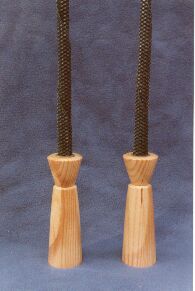 |
Last updated: January 21, 2000
Copyright
